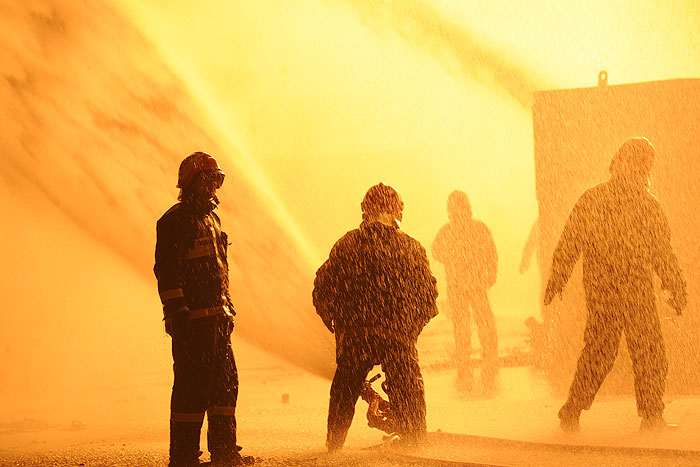The blowout of Well 147 of Rag Sefid oil field was brought under control after 58 days. The well is Iran's second largest gas dome in the oil field which holds more than 16.5 billion barrels of oil in place. Iranian specialists managed to apply their knowledge and expertise to cap blowout in an area, access to which is very difficult. Well 147 blew out on 29 October 2017 when directional drilling had reached the depth of 2,610 meters. This incident happened at a time when the drilling string had been taken out to examine the status of drilling bit and directional drilling equipment at the depth of 1,132 meters. At this depth, oil and gas gushed out and the blowout happened at 13:00 local time. Due to the blowout, drilling structure and substructure and every other related equipment were set ablaze. Within several hours, this structure of several hundred tonnes collapsed on blowout preventers and wellhead equipment. Consequently, the blowout preventers and wellhead equipment were damaged.
Immediately after the accident, a technical group was established quickly to make plans and arrangements for bringing the blowout under control.
Top Kill vs. Bottom Kill
Internationally there are two methods for containing well blowouts; top kill and bottom kill.
Top kill involves pumping heavyweight drilling mud into the well. This procedure is expected to stop the flow of oil and gas from the well. A further step could be sealing the well completely, often with cement.
Bottom kill involves drilling a relief well to the bottom of the borehole of the blown-out well, and pumping in heavy drilling fluid to counteract oil pressure and staunch the flow, then filling in the orifice to the oil reservoir with cement sealing the blowout and the relief wells.
In Rag Sefid, the first 28 days were spent on cleaning the well location of drilling cuttings so that the wellhead would be accessible. After cleanup which made the flames direct, specialized operations started for capping the blowout. It took 27 days.
Fourteen operations were conducted with different stingers and three operations with piston equipment. Throughout all these operations, the stingers and piston equipment were installed on Athey wagon and were connected with high-pressure lines.
Due to the high pressure of the Rag Sefid reservoir and subsequently the high pressure of the well, necessary arrangements had to be made for keeping the stinger on the head of the well. That was done by using two snub lines, placing weights and using two bulldozers.
Whereas due to the destruction of drilling structure and substructure, blowout preventers and wellhead equipment were damaged and bent approximately 30 degrees, fourteen specialized operations with Athey wagon and stinger failed to bring top kill into fruition.
The piston equipment, which had been developed by the private sector in collaboration with National Drilling Company (NIDC) and National Iranian South Oil Company (NISOC) and installed on Athey wagon, was used in three operations. This equipment could not be installed to bring the blowout under control due to the deviation of blowout preventers and unstable position of wellhead equipment.
When the blowout preventers standing right and the wellhead equipment were strong enough, the newly developed equipment would be likely to succeed. This equipment was composed of a structure fitted with a cylinder and high-pressure input and output lines for operation. By applying 1000 to 1500 psi pressure, the piston was pushed down and the anchor packer crossed the blowout preventers to be placed in the tubing head spool. By blocking the flow path, it created conditions for pumping drilling mud in order to kill the well under safe conditions.
In parallel with blowout control, the top kill got under way. The top kill operations were as follows:
1. Locating relief well C
2. Locating relief well A
3. Building a 70,000-barrel water pool
4. Locating drilling camps
5. Building access routes
All engineering and construction operations were carried out in 14 days, which was a record.
After locating relief wells A and C, Fath-93 and Fath-94 were installed during 7 and 10 days respectively before drilling started within a two-day interval from each other.
In light of geological location and given the drilling of Well 147 of Rag Sefid, relief well C was drilled vertically and relief well C was drilled directionally.
After the boreholes were drilled and casing strings were driven into the depth of 2,310 meters, a cap was installed. Then, drilling continued up to 2,332 meters. At this depth, entry into the Asmari reservoir was confirmed by geological survey.
Controlled drilling in the Asmari reservoir continued into the depth of 2,342 meters where swiveling was high. The objective was to reach the drainage radius of the well. When swiveling was observed, the drilling pipes and the bit were brought up to shoe 9 5/8. The well became safe and the well was filled. The killing lines were connected from three points to the wellhead and the drilling string.
After the 8000 psi lines were tested, the kill operation started by pumping water of 63 Pcf density, the pumping rate of 135 barrels per minute, pumping pressure of 2700 psi and wellhead pressure of 2500 psi with a pumping volume of 5,000 barrels. The return of water from the wellhead was seen. The continuation of water pumping along with a gradual decline in the pumping rate from 135 barrels per minute to 10 barrels per minute and simultaneously cleaning up the blowout preventers and the well pool, tubing head was reached and blowout preventers were separated from the wellhead equipment. New blowout preventers and well cap were installed and wellhead equipment was made safe before cement was pumped at a sufficient density to block the well. Well safety was completed and the blowout came under control after 58 days.
*Deputy CEO, National Iranian Drilling Company
By: Mehran Makvandi*
Courtesy of Iran Petroleum


Your Comment